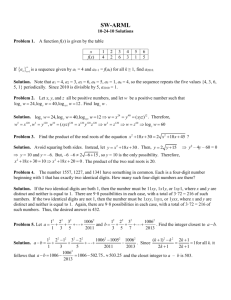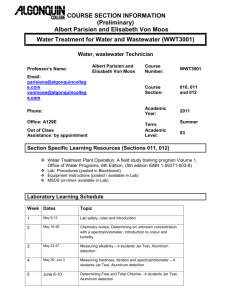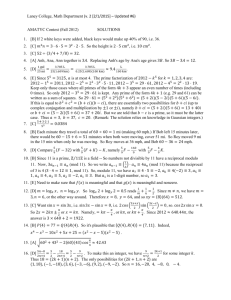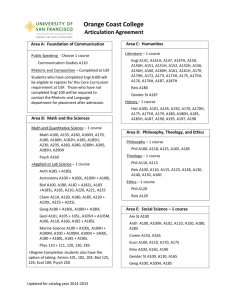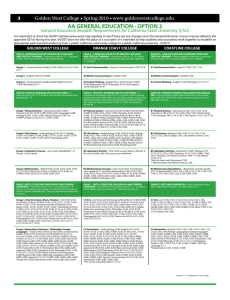Solutions - Missouri State University
advertisement
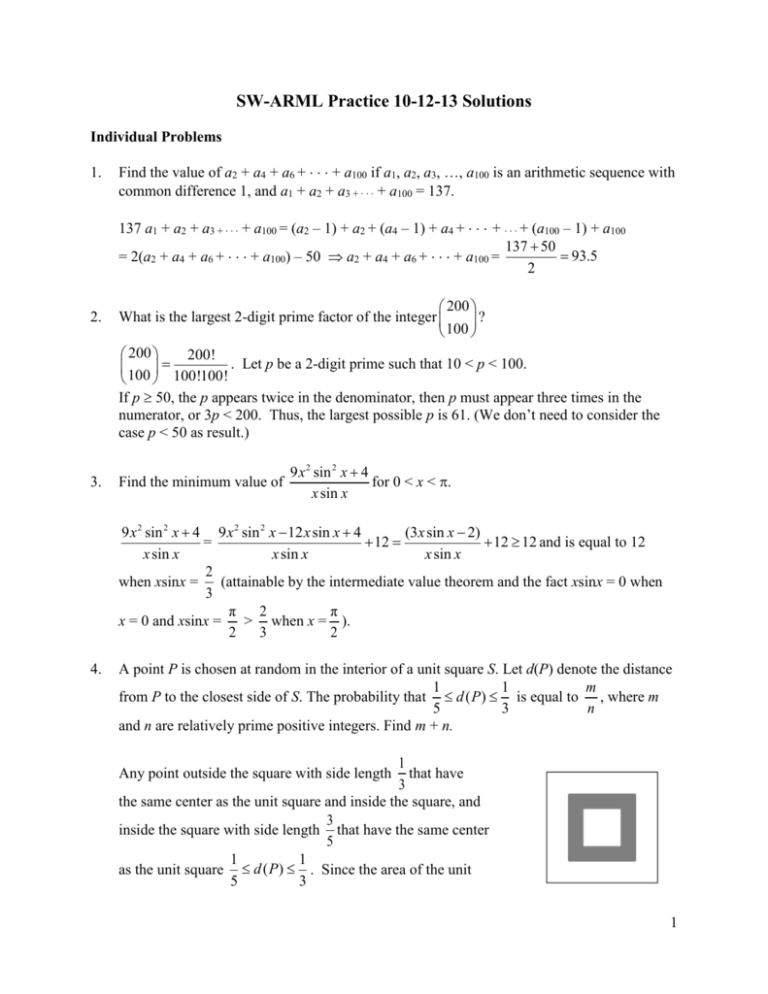
SW-ARML Practice 10-12-13 Solutions
Individual Problems
1.
Find the value of a2 + a4 + a6 + + a100 if a1, a2, a3, …, a100 is an arithmetic sequence with
common difference 1, and a1 + a2 + a3 + + a100 = 137.
137 a1 + a2 + a3 + + a100 = (a2 – 1) + a2 + (a4 – 1) + a4 + + + (a100 – 1) + a100
137 50
93.5
= 2(a2 + a4 + a6 + + a100) – 50 a2 + a4 + a6 + + a100 =
2
2.
3.
200
What is the largest 2-digit prime factor of the integer
?
100
200
200!
. Let p be a 2-digit prime such that 10 < p < 100.
100 100!100!
If p 50, the p appears twice in the denominator, then p must appear three times in the
numerator, or 3p < 200. Thus, the largest possible p is 61. (We don’t need to consider the
case p < 50 as result.)
Find the minimum value of
9 x 2 sin 2 x 4
for 0 < x < .
x sin x
9 x 2 sin 2 x 4 9 x 2 sin 2 x 12 x sin x 4
(3x sin x 2)
12
12 12 and is equal to 12
=
x sin x
x sin x
x sin x
2
when xsinx =
(attainable by the intermediate value theorem and the fact xsinx = 0 when
3
π
2
π
x = 0 and xsinx =
> when x = ).
2
3
2
4.
A point P is chosen at random in the interior of a unit square S. Let d(P) denote the distance
1
1
m
from P to the closest side of S. The probability that d ( P ) is equal to , where m
5
3
n
and n are relatively prime positive integers. Find m + n.
1
that have
3
the same center as the unit square and inside the square, and
3
inside the square with side length that have the same center
5
1
1
as the unit square d ( P ) . Since the area of the unit
5
3
Any point outside the square with side length
1
square is 1, the probability of a point P with
1
1
d ( P ) is the area of the shaded region,
5
3
2
2
9 1 56
3 1
which is the difference of the area of two squares:
. Thus, the
25 9 225
5 3
answer is 281.
5.
Positive numbers x, y, and z satisfy xyz = 1031 and log x (log yz) log y (log z) 168 .
Find
log x log y
2
2
(log z)2 .
xyz = 1031 log xyz = 31 log x + log y + log z = 31.
log x (log yz) log y (log z) 168
log x (log y) log x (log z) log y (log z) 168 (by using= log yz = log y log z )
Sine (a + b + c)2 = a2 + b2 + c2 + 2ab + 2ac + 2bc for all a, b and c, we have
2
2
log x log y (log z ) 2
= (log x + log y + log z)2 – 2[ log x (log y) log x (log z) log y (log z) ]
= 312 2168 = 961 – 336 = 625. Hence,
6.
log x log y
2
2
(log z )2 625 25 .
Let N be the number of ordered pairs of nonempty sets A and B that have the following
properties:
A B = {1, 2, 3, 4, 5, 6, 7, 8, 9, 10, 11, 12},
A B = ,
The number of elements of A is not an element of A,
The number of elements of B is not an element of B.
Find N.
Let us partition the set {1, 2, 3, … , 12}into n numbers in A and 12 – n numbers in B, where
0 n 12, and n must be in B and 12 – n must be in A.
In particular, n 6; otherwise, 6 would be in both A and B, but they are disjoint. Also,
n 12; otherwise 0 A, an impossibility; Similarly, n 0. Hence, 1 n 5 or 7 n 11.
10
We now have
ways of picking the additional numbers to be in A. Once the elements
n 1
of A are chosen, the rest is in B.
2
So the answer is
11 10 10 10 10 10 9 8 7 6
N n1
210 252 1024 252 772 .
n 0
n
1
5
n
1
2
3
4
5
7.
Find the number of second-degree polynomials f(x) with integer coefficients and integer
zeros for which f(0) = 2013.
Let f(x) = a(x – r)(x – s) for some integers a, r, and s. Then, ars = 2013 = 31161.
Case I: Both r and s are positive (and thus a). There are 33 = 27 ways to split up the prime
factors among a, r, and s. However, r and s are indistiguishable. In one case, (a, r, s) =
(2013, 1, 1), we have r = s. The other 26 cases are double counting, so there are 13, where
r s.
Case II: Either of r or s could be negative.
i. When r s, there are four different possibilities (+, +), (+, ), (, +), and (, ).
ii. Whenr = s, then (r, s) = (1, 1), (1, 1), and either (1, 1) or (1, 1).
The total is 413 + 3 = 55.
8.
Jar A contains four liters of a solution that is 45% acid. Jar B contains five liters of a
solution that is 48% acid. Jar C contains one liter of a solution that is k% acid. From jar C,
m
liters of the solution is added to jar A, and the remainder of the solution in jar C is added
n
to jar B. At the end both jar A and jar B contain solutions that are 50% acid. Given that m
and n are relatively prime positive integers, find k + m + n.
One may first combine all three jars in to a single container. That container will have 10
liters of liquid, and it should be 50% acidic. Thus there must be 5 liters of acid.
Jug A contained 45%4L = 1.8L of acid, and jug B 48%5L = 2.4Lof acid.
Hence jar C contains 5 – 1.8 – 2.4 = 0.8L acid (out of 1 liter), so k = 80.
m
m
m
m 2
m
m
(80%) 1.8 4 (50%) 1.6 3.6 4 0.6 0.4
n
n
n
n 3
n
n
So, m = 2 and n = 3, and k + m + n = 85.
Then,
9.
What is the product of the real roots of the equation x2 + 18x + 30 = 2 x2 18x 45 ?
Squaring both sides will make it too difficult to handle. Instead, let y = x2 + 18x + 30.
3
Then the equation becomes y = 2 y 15 y2 = 4y + 60 y2 4y 60 = 0
(y – 10)(y + 6) = 0 y = 10 or y = 6 (extraneous) y = 10
x2 + 18x + 30 = 10 x2 + 18x + 20 = 0
the product of the real roots is 20.
10. Let an = 6n + 8n for all positive integers n. Determine the remainder upon dividing a83 by 49.
83 83 82 83 81 83 80
83
7 7 7 7 7 1
1
2
3
82
a83 = (7 – 1)83 + (7 + 1)83 =
83
83
83
83
783 782 781 780 7 1
1
2
3
82
83
83
83
83
= 2 783 781 779 73 7
2
4
80
82
83
All but the last term is divisible by 49, so the remainder is equal to the remainder of 2 7
82
83
when divided by 49. Since 2 7 = 2837 = (166)7 = (237 + 5)7 = 2349 + 35.
82
Hence, the remainder is 35.
4



